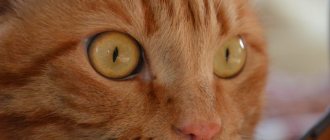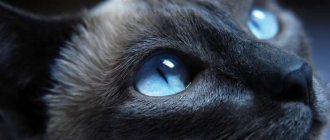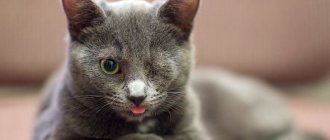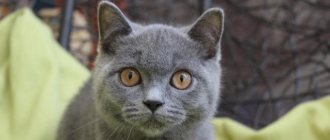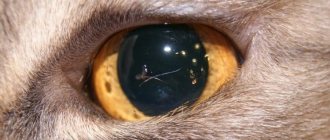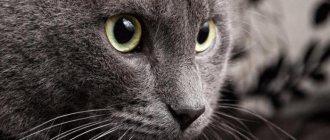Have you ever looked into your cat's eyes and wondered what she sees when she looks at you? Cats see people completely differently from people, so it is very interesting to find out exactly how they see their beloved owners. Their gaze is uniquely feline, and understanding this can help us understand our pets a little better.
Features of cat vision
The cat's organ of vision differs sharply from the human one in structure and ability to perceive space. They have large, round eyes with a convex lens. The viewing angle of space is 270 degrees.
A special feature of cats is stereoscopic vision. Each eye receives its own image of an object, which is then combined by the brain into one three-dimensional picture. As a result, the predator receives accurate information about the location of the prey and the distance to it.
Everything that the left eye sees goes to the right side of the brain and, conversely, the right eye transmits the picture to the left half
The genetic memory of a predator makes animals react to moving objects. Stationary animals are practically of no interest to them. Watching a moving object, the animal begins to actively move its head up and down: this is how the cat changes its viewing angle and focuses on the prey. This natural ability helps the predator calculate the distance to the prey down to the millimeter, which is why the cat’s jump is so accurate.
The special sensitivity of a cat's eyes is directly related to the structure of the pupil. It is located vertically and has increased elasticity. In bright light, it narrows, limiting rays from reaching the retina. Lack of lighting causes the pupil to dilate greatly, allowing more light to enter.
The sensitivity of a cat's eye is 6–8 times greater than that of a human. The reason for this is a special layer behind the retina called tapetum. It is a shell of vessels that look like mother of pearl.
Peculiarities of color and contrast perception
Compared to humans, color discrimination in cats is much weaker. She distinguishes the contours of objects well, but their colors appear blurry to her, especially at the periphery.
Cat vision occupies an intermediate position between color and black and white . Visual analyzers are insensitive to the average wavelengths of the green part of the spectrum. The whole world is seen in pastel greenish-gray, blue-sand tones, but red, brown and orange are not perceived.
Shades of blue and green appear faded, and purple appears blue. Yellow and blue colors are perceived best by a cat's vision; other shades partially fall out of the picture of the world, being replaced by those closest to them in the color spectrum.
Compared to human eyes, cat eyes not only distinguish shades weaker, but also see everything around them with much less contrast. Their vision is “sharpened” to detect a moving target and correctly estimate the distance to it, which is necessary to calculate the force of a jump during a hunt. Therefore, cats are good at distinguishing moving objects, while stationary ones often escape their attention. For example, an animal may not notice a person standing motionless nearby.
How many colors can cats distinguish?
Until recently, there was an opinion that cats do not distinguish colors. It was assumed that all objects looked gray to them, similar in shades to mice. The main argument for this was that cats simply do not need color vision, because they hunt at night.
Recent research by scientists has refuted this claim. It has been proven that cats cannot distinguish only a few shades: orange, brown, red, green. Their eyes can see blue, violet, gray, and yellow colors. This perception is based on an increased number of cones in the eye, which decipher blue and green colors. There are practically no cones sensitive to shades of red in the eyes of these animals. Therefore, red colors are not available to cats.
Basically, the world from a cat's point of view looks bluish-gray, since they perceive purple and yellow colors less well.
There is no bright picture before the cat’s eyes, but her world is by no means gray
Why are cats dangerous?
Furballs can cause trouble. First of all, these are dangerous diseases: rabies, helminthiasis, lichen, toxoplasmosis. They can be transmitted to humans in certain cases, some of them are deadly.
In terms of energy, well-being in the home, and good luck, animals sometimes bring trouble, as evidenced by the following beliefs:
- Drowning kittens means a dead person will appear in the family;
- Killing a cat, even a sick one, means endless trouble;
- If you drive away a cat that has come into the house, there will be no luck for 7 years;
- Dousing an animal with water means you won’t live to old age;
- Hit an animal - go to jail;
Thus, the cute animal can cause trouble. Believe this, do not have an animal at home.
How far can he see
The maximum distance at which a cat can clearly see objects is 60 meters, but to him an image at such a distance looks like a solid blur. The range of vision is limited to a distance of 20 meters. Scientists explain this feature by the fact that the predator hunts from an ambush, and there is no need to distinguish distant objects.
At too close a distance, cats also do not perceive what is in front of their eyes. An object brought closer to the muzzle than 50 cm is recognized by the animal’s senses of touch. This feature should be kept in mind when playing with your pet.
Domestic predators most clearly see objects located at a distance of 75 cm to 6 m. They need this value to calculate the height and length of the jump for prey.
Differences with human vision
Of course, it's all about the brain. Unlike humans, cats have developed areas of the brain that are responsible for hearing and smell, so vision in cats is worse than these senses. In humans, most of the neurons are taken away by hand motor skills.
Unlike other creatures, a cat's vision is an auxiliary sense, and not the main one - hearing and smell are considered the main ones. Evolution put everything in its place due to the fact that the cat is considered an animal that hunts from an ambush. That is why she does not need a far-sighted gaze of several kilometers.
Dogs see better than cats, and this is also due to brain development. The structure of the limbs and their work in the cat family is much more complex, therefore, together with the development of areas responsible for hearing and smell, there is no room left for vision on the surface of the cerebral cortex in cats, and they see worse.
How they see in the dark
The idea that cats navigate in pitch darkness is a myth. The animal sees in minimal light. A cat only needs 10% of the lighting that a human needs. People cannot see anything in such illumination. But this animal is a predator, so its eyes are equipped with additional receptors that have increased sensitivity to light. The tapetum on the back wall of the retina, like a mirror, reflects light twice, which is why cats' eyes glow so much in the dark. In fact, the eyes do not glow, but reflect the rays that hit them.
Cats look at us with multi-colored eyes. Colors like yellow amber, blue sea, blue sky, green grass or bright gold
Good orientation in the space of a dark room is explained by the fact that vision is not the only organ with which cats perceive the world. The secret of the animal is in the especially sensitive organs of touch - vibrissae.
Vibrissae (whiskers) are unique sensors that send information about surrounding objects to the cat’s brain.
Excursion into history
As you know, the first people to domesticate cats were the ancient Egyptians. Ever since the wild predator began to live side by side with humans, it never ceases to amaze. The naive inhabitants of Egypt believed that she would serve them - to catch mice. It was for this purpose that they were tamed.
© shutterstock
However, very soon they themselves began to serve and worship the cat, considering it a supreme being, almost a deity. People sculpted animal figures and used them during rituals. The dead were buried not just anywhere, but in tombs - next to the pharaohs.
Many things surprised people about cats. For example :
- They know how to appear as if from nowhere and go as if to nowhere. People don’t see them for a long time, and then they come.
- They walk on their own, demonstrating complete independence.
- They do not obey the will of the owner, like, for example, dogs, but act as they please.
Perhaps cats behave this way because they feel protected by the other world and higher powers. People have thought about this more than once. In the Middle Ages, it was for this reason that cats were burned at the stake along with witches. Each person considered it almost his duty to destroy as many tailed creatures as possible.
They were perceived as messengers of the other world, assistants of Satan, and evil spirits. It's scary to imagine how many cute cats have become victims of their reputation. Black individuals suffered especially. It was the mass extermination of representatives of the cat family that largely provoked plague epidemics.
After the mass extermination of animals, there was no one to destroy the main carriers of the infection - rodents. It turns out that people, having paid for their stupidity and cruelty, themselves went to the other world.
Time passed, and barbaric methods became a thing of the past. However, even today many believe that cats can see objects of the other world. This frightens some, but delights others. It is difficult to find a person who would be completely indifferent to cats.
© shutterstock
What is the connection with the other world?
Cats often observe objects that are not visible to humans. They suddenly jump up and start running around the room, knocking them over. At such moments, the animal’s pupils are dilated and its fur stands up. This behavior makes one believe that the cat sees the other world and its inhabitants. His gaze is accessible to what a person is unable to see.
When an animal looks into emptiness or, turning its head, examines an empty wall, there is no reason to worry. This is explained by the fact that even the quietest sounds that are alarming are accessible to a cat’s hearing. They do not come from the other world, but, quite possibly, from under the baseboard. The grandmothers’ assertion that at such moments the domestic predator communicates with the brownie is also from the realm of half-fairy tales.
Over the centuries, cats have been the source of scary stories thanks to their ability to see in the dark.
But the cat’s connection with a world unknown to man still exists. If your pet begins to behave restlessly, for no apparent reason, it is advisable to consecrate the home. Esotericists claim that a cat, having noticed an otherworldly body on its territory, tries to protect its owner from it. First, the animal freezes, trying to assess the “alien”’s intentions. If the cat thinks that the uninvited guest is dangerous for the owner, she tries to force him out with her own energy. When the danger is too strong and the cat cannot cope with it, it may even leave the house. It is not uncommon for cats to return as unexpectedly as they left. So the pet removes evil spirits from the home, and after getting rid of it outside the walls of the house, it returns.
Scientists do not see anything mystical in this behavior of cats and claim that any behavior of a cat is explained by its increased sensitivity to sounds and smells.
But no evidence has been presented to refute the ability of cats to see the inhabitants of the other world, so you can still believe in the supernatural power of a cat’s vision.
Do cats see us as another species?
Cats treat people as if they think we are giant and clumsy conversationalists. When a cat rubs up against a person and raises its tail, it greets us the same way it greets another cat. Cat behavior researcher John Bradshaw from the University of Bristol says cats probably consider us particularly clumsy, or rather most people by cat standards. They can also see us as their family.
When a cat kneads you with its paws, it treats you the same way a kitten treats its mother. Kneading is a kitten's way of asking for milk. In other cases, if your cat is trying to "groom" you, she may treat you like her own kitten.
We also recommend reading:
Pet: why does the dog refuse to go for walks When and why do kittens change eye color? Why a cat won't accept kittens, and how to deal with it Unusual facts about the cat's nose
How they see our world
To see our world through the eyes of a cat, you need to look at a faded, blurry photograph. Nature has provided for the ability of predators to clearly see moving prey without paying attention to small details. A cat's eyes do not provide a complete picture of the world, so their vision is supplemented by other senses.
Cats see immediately with their eyes, nose and vibrissae - sensitive organs located on the face and tail. It is much more important for them to touch and smell an object than to just see it.
Do they see the image on TV and their reflection in the mirror?
Scientists are divided on the perception of images on a TV screen. Some argue that animals see flickering and movement of objects. To confirm this, many owners testify that their pets love watching animals on the screen, and after switching the channel they immediately lose interest in the TV.
Cats not only love to watch TV, but also sleep on it.
Others are sure that TV programs in the eyes of animals look like static pictures replacing each other. They explain this fact by the fact that cat's eyes perceive images at a speed of 40 frames per second. In this case, the TV is configured for human perception, that is, 24 frames. For an animal to see movement on the screen, the frame must be updated 50 times per second.
In the mirror, the cat sees itself normally, but begins to hiss and flatten its ears. This behavior indicates fear. The image without odor and auditory vibrations is incomprehensible and causes fear.
How cats see humans
Pets see people as they are. They adequately assess height, recognize movements and voice. But animals see a clear picture only at a distance of 0.5 to 5 meters. At a distance of 7–10 meters, the pet sees only a silhouette and can recognize the owner by smell and voice.
There is an opinion that, in addition to the physical body of a person, cats can see his biofield. This ability can explain different attitudes towards strangers. The animal approaches some without fear, allows itself to be petted, and even goes into your arms. He doesn't let some strangers come close to him. The animal evaluates a person's aura and accurately determines who may pose a danger to him.
The ability to see the aura is reflected in the cat’s ability to identify a sore spot on the owner’s body. The pet draws out the negative energy of the owner, thereby having a beneficial effect on his health.
If a cat living in a house is constantly sick and no treatment helps, the owners should think about their own health.
By the way a domestic predator looks at a person, you can understand what his mood is at the moment and guess his desires:
- peace and tranquility is expressed by squinting eyes and constricted pupils;
- fear is reflected in wide open eyes and maximally dilated pupils;
- when the pet intends to beg the owner for a treat, the gaze becomes intent, straight into the person’s eyes;
- if an animal, without looking away, looks at a person, periodically slowly closing its eyes, it expresses its love.
What does a cat see in the mirror and on TV?
Surely each of us has observed at least once in our lives how cats behave in front of the mirror. It is impossible to look at this without laughing: the animal, with its ears flattened, literally attacks him, arching its back and bristling its whiskers. Reacting so violently to their own reflection, cats don’t even realize that they see themselves. In fact, they are not frightened by the reflection as such, but by the fact that they perceive it as the presence of another animal, information about which is not transmitted by auditory and tactile receptors. They simply cannot understand how it is that they see their relative in front of them, but at the same time they cannot even smell him.
As for TV, most researchers argue that our four-legged friends only see flickering, but objects moving on the screen still interest them to some extent. For example, cats love to watch programs about animals. Without taking their eyes off, they watch the flight of birds, the hunt of tigers, lions and other felines, as if spellbound. If you turn off the sound, it will not affect the cat in any way; it will continue to watch. But as soon as you change the channel, your cat will lose interest in what is happening on the screen and even leave the room. Scientists cannot yet understand how cats selectively see or understand that they are showing “their” birds or the same birds (object of hunting) on TV.
Vision problems: how to notice them
Cats suffer from various vision disorders quite often. The owner should be wary if the animal hides its eyes from bright light or often rubs its face with its paws. Signs of inflammation are frequent blinking of the pet, pus in the corners of the eyes, clouding of the whites, swelling of the eyelids. Any of these signs is a reason to immediately consult a veterinarian.
Kittens that are blind at an early age have much longer whiskers than their kittens. This is how nature compensates for the lack of visual perception of the world
Some eye diseases can cause complete blindness in your pet. It is difficult to notice vision problems in cats in order to take timely measures, since they are able to navigate in space even with complete blindness. The following signs indicate that vision problems have begun and should be checked:
- the animal does not jump to its favorite places located at a height or, when jumping, misses and falls;
- when moving around the house, he comes across moved or new furniture, objects standing in unusual places;
- your pet’s pupils do not constrict in bright light;
- stops responding to favorite toys;
- when the pet looks at the owner, his gaze does not focus on him.
All these signs indicate a deterioration in the cat’s vision or the onset of blindness.
What to do if your cat begins to see poorly
Unfortunately, it is not always possible to restore a pet’s vision, but this is not a reason to abandon a sick animal. The owner should organize the space of the home in such a way that the animal feels comfortable. Your pet can live a full life if you do the following:
- do not change the location of bowls with food and water;
- do not let the animal out into the street unattended, take it for a walk on a leash;
- in a new room, accustom the cat to the location of objects, without frightening them and allowing them to find their own way;
- do not block the path with boxes, scattered toys and other objects.
Visual impairment in cats
Just like humans, cats can suffer from visual impairment. Their eyes are very vulnerable. In individuals leading a wandering lifestyle, purulent discharge from the eyes can often be observed. These are symptoms of infections and the consequences of unsanitary conditions in which animals have to live - dirty basements, garbage dumps.
Some cat breeds (Bengal, Abyssinian, Persian) have a congenital predisposition to progressive retinal atrophy, which ultimately leads to complete blindness. The vision of Siamese cats is sometimes affected by a defective gene that impairs binocularity. Blue-eyed cats often experience a decrease in visual acuity at night due to weak pigmentation of the tapetum.
Improper feeding is another cause of visual impairment. So, if there is not enough taurine in the food, the cat’s visual acuity decreases, and in severe cases, retinal degeneration occurs.
Does a cat see paranormal phenomena?
In some cases, observing attacks of unprovoked excitement in a cat, the owner is inclined to associate them with the influence of paranormal factors. It is often said that cats see the spirits of the dead or play with brownies. But as a rule, the cat simply hears sounds or smells that are inaccessible to human perception, and reacts to them.
The cat picks up sounds that are inaccessible to the human ear, but they are not at all supernatural
Many phenomena, for example, electromagnetic fields, ultrasonic waves, radiation, are imperceptible to the human senses, but perhaps the cat perceives them and reacts accordingly.

